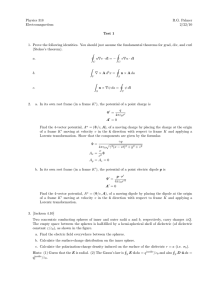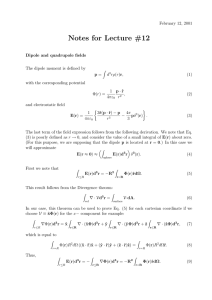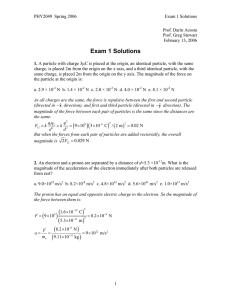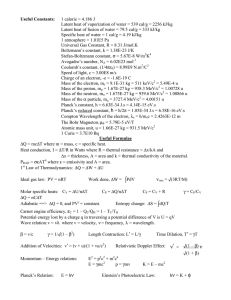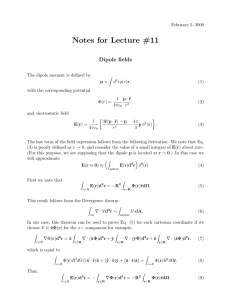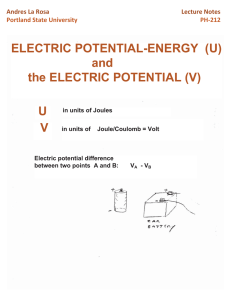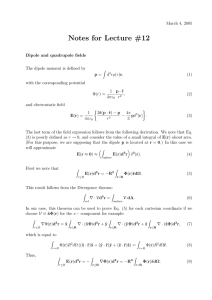PHYS 122 - General Physics II
advertisement
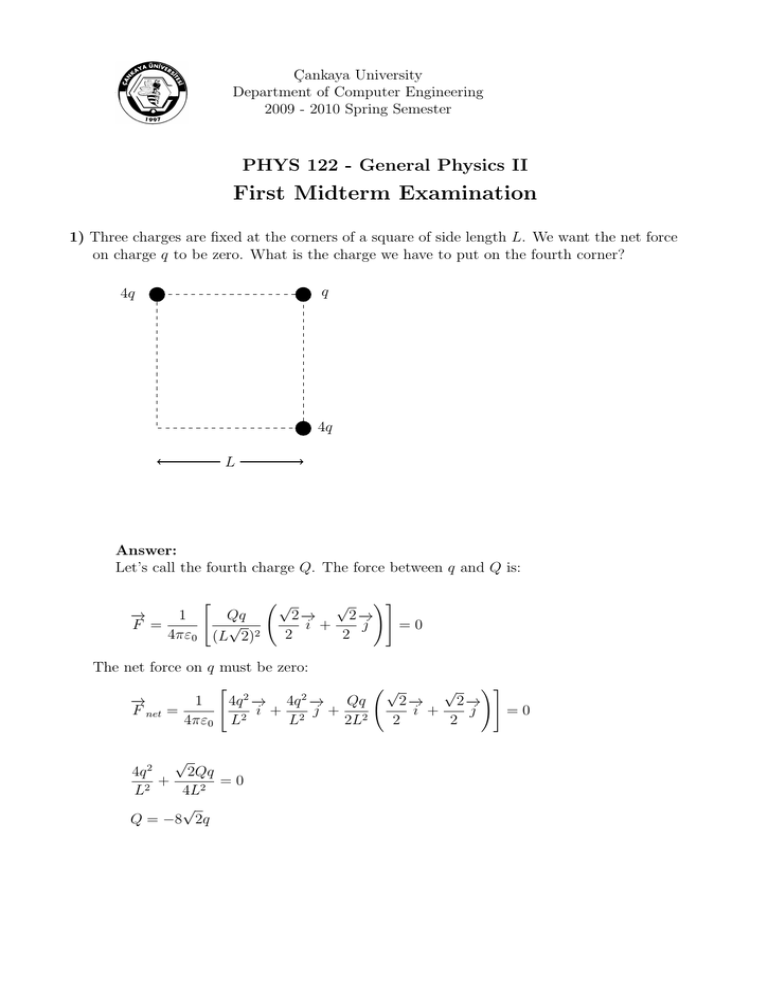
Çankaya University Department of Computer Engineering 2009 - 2010 Spring Semester PHYS 122 - General Physics II First Midterm Examination 1) Three charges are fixed at the corners of a square of side length L. We want the net force on charge q to be zero. What is the charge we have to put on the fourth corner? q 4q 4q L Answer: Let’s call the fourth charge Q. The force between q and Q is: → − F = " 1 Qq √ 4πε0 (L 2)2 √ !# √ 2→ 2→ − − i + j =0 2 2 The net force on q must be zero: " → − 4q 2 → 4q 2 → Qq 1 − − i + j + 2 F net = 2 2 4πε0 L L 2L √ 4q 2 2Qq + =0 2 L 4L2 √ Q = −8 2q √ !# √ 2→ 2→ − − i + j =0 2 2 2) A total charge Q is distributed uniformly on a rod of length L. Find the electric field at the point P in unit vector notation. (Do not evaluate the integrals) P b + + + + + + + + + + + 3L 4 + + + + L 4 Answer: dq = dE = Q dx L 1 dq 2 3L 4πε0 b2 + −x 4 dEx = dE sin θ, dEy = dE cos θ Z L 3L −x Q 4 Ex = h 2 i3/2 dx 4πε0 L 0 3L 2 b + 4 −x Z L b Q Ey = h 2 i3/2 dx 4πε0 L 0 3L 2 b + 4 −x or alternatively Q Ex = 4πε0 L Z Q Ey = 4πε0 L Z L 4 − 3L 4 x [b2 L 4 − 3L 4 + x2 ]3/2 b [b2 → − → − → − E = Ex i + Ey j + x2 ]3/2 dx dx 3) A non-conducting spherical shell has inner radius a and outer radius b. It has uniform volume charge density ρ. Find the electric field for a) r < a b) a < r < b c) b < r ρ b O a Answer: Using Gauss’ Law: a) 4πr2 E = qenc ε0 E=0 b) 4πr2 E = E= 2 − 43 πa3 ρ ε0 (r3 − a3 )ρ 3r2 ε0 c) 4πr E = E= 4 πr3 3 4 πb3 3 (b3 − a3 )ρ 3r2 ε0 − 34 πa3 ρ ε0 4) Find the work we have to do to assemble the system shown in figure, bringing each charge from infinity: b 2b q 2q b 3q 4q Answer: 1 U= 4πε0 U= q 2q q 3q q 4q 2q 3q 2q 4q 3q 4q + + + + + b 3b 4b 2b 3b b 65 q 2 3 4πε0 b 5) On a certain region of space, the electric potential is given by V (x, y, z) = Find the electric field. Answer: − → − ∂V → ∂V → ∂V → − − i − j − k E =− ∂x ∂y ∂z → − E = x yz 2 − p x2 + y 2 ! → − i + xz 2 − p y x2 + y 2 ! → − → − j + 2xyz k p x2 + y 2 −xyz 2 . Çankaya University Department of Computer Engineering 2009 - 2010 Spring Semester PHYS 122 - General Physics II Second Midterm Examination 1) a) A capacitor stores an energy of 1µ j when the potential difference between its plates is 3 V . Find its capacitance. b) Find the charge on the 4 pF capacitor in the figure. 1 pF 4 pF 60 V Answer: a) 1 U = CV 2 2 C= 12µj 2U = 2 V (3V )2 C = 0.22µF = 2.2. × 10−7 F b) 1 1 1 1 1 = + = + Ceq C1 C2 1 pF 4 pF Ceq = 0.8 pF q = V C = 60V 0.8pF = 48 pC q1 = q2 = 4.8 × 10−11 C 2) A cylindrical wire made of Nichrome has radius r = 1 mm and length L. Nichrome’s resistivity is ρ = 5 × 10−7 Ω · m. When a potential difference of 100 V is applied, the power dissipation is 2000 W . Find L. Answer: P = (100V )2 V2 = = 5Ω R 2000W R= ρL A L= π(10−3 m)2 5Ω = 10π = 31.4 m 5 10−7 Ω m ⇒ L= AR ρ 3) In the following circuit, a) Find all currents b) Find Vab . 4Ω 8Ω b 1Ω 3Ω 2Ω 7V a 80V 60V Answer: i1 + i2 i2 i1 80 − 7(i1 + i2 ) − i1 − 7 = 0 7 + i1 − 10i2 + 60 = 0 8i1 + 7i2 = 73 −i1 + 10i2 = 67 The solution of the system of equations give: i2 = 7 A, i1 = 3 A, i1 + i2 = 10 A Vab = +7 + 3 − 56 = −46V 4) A charged particle with mass m, charge q, kinetic energy K enters a magnetic field and then follows a circle of radius r as seen in the figure. Find the magnitude and direction → − of the magnetic field B . r → − B m, q Answer: 1 K = mv 2 2 r= ⇒ v= p 2K/m mv qB p m 2K/m mv B= = qr qr √ 2Km B= qr → − Using the right hand rule, we see that B is into the page. 5) A current of I flows around a square of side length a. Find the magnitude of the magnetic field at the center of the square. Answer: I a C a 2 Using Biot-Savart law for one side of the square, we obtain the magnetic field at C as: Z π/4 B= −π/4 µ0 I cos θ dθ 4π(a/2) π/4 µ0 I B= sin θ 2πa −π/4 √ µ0 I 2 B= 2πa If we add the magnetic fields of all four sides: √ µ0 I Btotal = 2 2 πa Çankaya University Department of Computer Engineering 2009 - 2010 Spring Semester PHYS 122 - General Physics II Final Examination 1) Find all currents in the following circuit: 8Ω 8Ω 4Ω 17Ω 40V 5Ω 15V 10Ω 10V 47V 6Ω Answer: Let’s choose the currents as follows: i1 i2 i1 + i2 Now, using Kirchoff’s loop rule, we obtain: +10 − 10i2 + 40 − 8i2 − 8i2 + 17i1 − 15 = 0 +15 − 17i1 − 4(i1 + i2 ) − 5(i1 + i2 ) + 47 − 6(i1 + i2 ) = 0 −17i1 + 26i2 = 35 32i1 + 15i2 = 62 The solution of this system of equations give: i1 = 1A, i2 = 2A, i1 + i2 = 3A 2) a) The time constant of an RC circuit is τ = RC = 0.05 s. Find the time necessary for initially uncharged capacitor to be charged to 99% of its final charge. Answer: q = CE(1 − e−t/RC ) Final charge is CE therefore q = 0.99 CE. 0.99 = 1 − e−t/τ e−t/τ = 0.01 −t/τ = ln 0.01 t = 0.05s. × 4.6 = 0.23s. b) A particle of mass m, charge q travels in a circular path of radius R in a uniform magnetic field B. Find its period of revolution. Answer: r= mv qB T = 2πr v T = 2πm qB 3) A variable magnetic field of magnitude B = B0 (1 + t3 ) is perpendicular to a rectangular loop. The loop has dimensions a × b and resistance R. Find the magnitude and direction of the induced current. R → − B a Answer: ΦB = BA = Bab = B0 (1 + t3 )ab dΦB = −B0 3t2 ab dt 3B0 t2 ab E =− I= R R Positive direction is counter-clockwise. Therefore I is in clockwise direction. E =− b 4) a) In a series RLC circuit, L = 90 mH, C = 1.5 µF and f = 0.8 kHz. If the phase constant is 55◦ , what is the resistance of the coil? Answer: ω = 2πf = 5027s−1 XL = ωL = 452 Ω 1 XC = = 132 Ω ωC X L − XC = tan 55 = 1.428 R XL − X C R= = 224 Ω tan φ b) An oscillating LC circuit is made of a 4 nF capacitor and a 9 mH inductor. The maximum current is 3 A. What is the maximum charge on the capacitor? 2 1 2 1 qmax LImax = 2 2 C √ qmax = LC I √ qmax = 9 · 10−3 · 4 · 10−9 3 qmax = 18 µC 5) a) The displacement current through a rectangular loop of area 3.5 m2 is 8 A. At what rate is the electric field through the loop changing? id = ε0 d(EA) dE dΦE = ε0 = ε0 A dt dt dt dE id 8 = = dt ε0 A 8.85 · 10−12 · 3.5 dE = 2.58 × 1011 V /m.s dt b) The maximum electric field of an electromagnetic wave is 5 V /m. What is the intensity? I= 2 Erms E2 = m cµ0 2cµ0 52 I= 2 · 3 · 108 · 4π · 10−7 I = 0.033 W/m2 Prepared by: Dr. Emre Sermutlu (2010)

